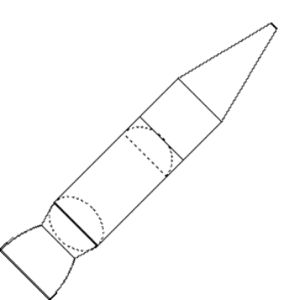
Home - Search - Browse - Alphabetic Index: 0- 1- 2- 3- 4- 5- 6- 7- 8- 9
A- B- C- D- E- F- G- H- I- J- K- L- M- N- O- P- Q- R- S- T- U- V- W- X- Y- Z
OOST stage
 ROOST Improved ROOST Improved Specific Impulse Credit: © Mark Wade |
AKA: OOST. Status: Study 1963. Thrust: 123,191.00 kN (27,694,438 lbf). Gross mass: 7,982,000 kg (17,597,000 lb). Unfuelled mass: 431,000 kg (950,000 lb). Specific impulse: 410 s. Specific impulse sea level: 345 s. Burn time: 242 s. Height: 85.40 m (280.10 ft). Diameter: 21.30 m (69.80 ft). Span: 21.30 m (69.80 ft).
Douglas Aircraft Co. engineer Phil Bono did much to promote the concept of reusable ballistic space vehicles during the 1960s. Bono and his team at Douglas Aircraft examined fifteen different Nova concepts during 1962-64, including two nuclear powered vehicles. Safety considerations would however rule out the possibility of using nuclear power on vertical takeoff-&-landing SSTOs such as the RITA concept. HTHL SSTOs were also rejected as impractically large since they require a very large wing area to keep wing loading within acceptable limits; the total area will be bigger than is needed to store the liquid hydrogen fuel. Smaller wings, on the other hand, would produce prohibitive landing velocities. Consequently, the only realistic SSTO launch and landing configuration appeared to be VTVL.
Among the reusable chemical rocket concepts, winged two-stage vehicles such as ASTRO would have to be impractically large for heavy-lift missions. The preferred reusable concept was ROOST (Recoverable One Stage Orbital Space Truck, left), which would have used an inflatable blunt-body drag cone for recovery at sea. ROOST would have impacted the water at 33.5 meters per second so the refurbishment cost would have been high. An alternative "buoyant" ROOST would have incorporated a buoyancy torus and ballute/balloon inflated by warm residual hydrogen to reduce the landing speed, but the additional mass of the recovery system naturally increased the gross liftoff weight too. Another possibility was that the vehicle could be recovered in air by a helicopter and towed, under aerostatic lift, to a refurbishment site. ROOST would have cost $16/lb (7-8 reuses) vs. $250/lb for the Saturn V at 1962 rates. The equivalent costs in 1999 dollars would be $195/kg for ROOST and $3,040/kg for the Saturn V.
Bono concluded that high pressure LOX/LH2 engines and a 7-1 oxygen/hydrogen mixture ratio would reduce the size & weight of the vehicles. Disposable tanks & parallel staging were initially rejected since complex cross-plumbing would be required, but Douglas would rather return to the drop tank concept in order to achieve greater weight margins for its future SSTO designs.
No Engines: 4.
Country: USA. Engines: 5 mlbf. Launch Vehicles: OOST. Propellants: Lox/LH2.
Back to top of page
Home - Search - Browse - Alphabetic Index: 0- 1- 2- 3- 4- 5- 6- 7- 8- 9
A- B- C- D- E- F- G- H- I- J- K- L- M- N- O- P- Q- R- S- T- U- V- W- X- Y- Z
© 1997-2019 Mark Wade - Contact
© / Conditions for Use